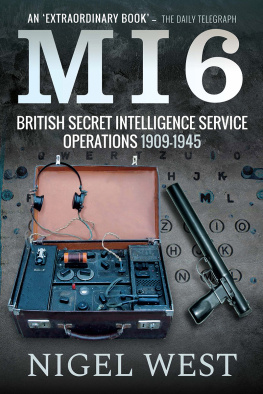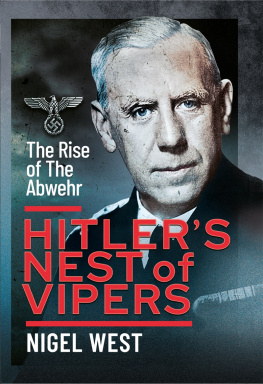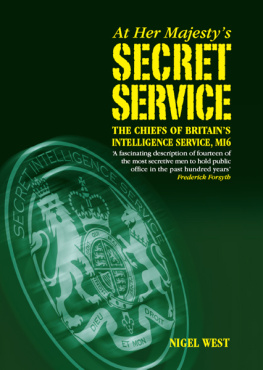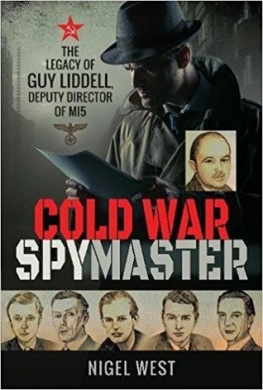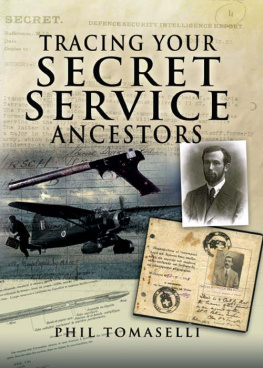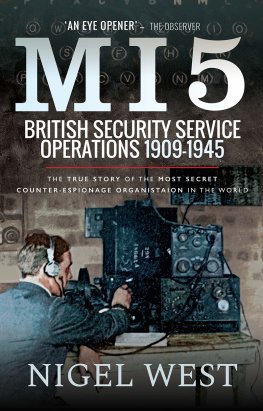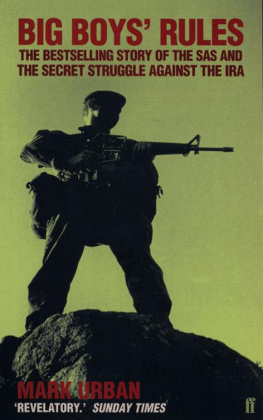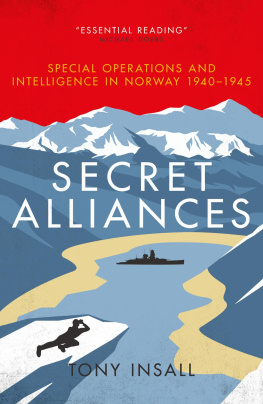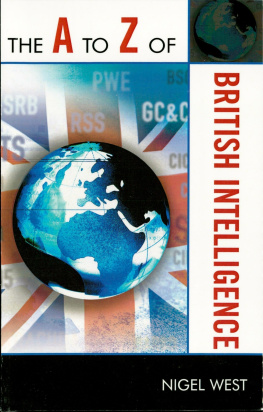Pagebreaks of the print version

MI6
MI6
BRITISH SECRET INTELLIGENCE SERVICE OPERATIONS 19091945
NIGEL WEST
Frontline Books
MI6
British Secret Intelligence Service Operations, 19091945
This edition published in 2019 by Frontline Books,
an imprint of Pen & Sword Books Ltd,
47 Church Street, Barnsley, S. Yorkshire, S70 2AS
First published by Weidenfeld & Nicolson, London, 1983.
Copyright Nigel West
ISBN: 978-1-52675-574-2
eISBN: 978-1-52675-575-9
Mobi ISBN: 978-1-52675-576-6
The right of Nigel West to be identified as Author of this work has been asserted by him in accordance with the Copyright, Designs and Patents Act 1988. A CIP catalogue record for this book is available from the British Library.
All rights reserved.
No part of this book may be reproduced or transmitted in any form or by any means, electronic or mechanical including photocopying, recording or by any information storage and retrieval system, without permission from the Publisher in writing.
Pen & Sword Books Ltd incorporates the imprints of Pen & Sword Archaeology, Air World Books, Atlas, Aviation, Battleground, Discovery, Family History, History, Maritime, Military, Naval, Politics, Social History, Transport, True Crime, Claymore Press, Frontline Books, Praetorian Press, Seaforth Publishing and White Owl
For a complete list of Pen & Sword titles please contact:
PEN & SWORD BOOKS LTD
47 Church Street, Barnsley, South Yorkshire, S70 2AS, UK.
E-mail:
Website: www.pen-and-sword.co.uk
Or
PEN AND SWORD BOOKS,
1950 Lawrence Roadd, Havertown, PA 19083, USA
E-mail:
Website: www.penandswordbooks.com
Illustrations
21 Queen Annes Gate, the elegant headquarters of the Passport Control Office and the London residence of the CSS (Nigel West)
Major-General Sir Stewart Menzies, KCB, KCMG, DSO, MC, Chief of the Secret Intelligence Service 1939-53 (courtesy of Charles Whiting)
The British Passport Control Office in a quiet suburb of The Hague (Nigel West)
A German newspaper headlines the Venlo incident (Sddeutscher Verlag/Bavarian Ministry of Finance)
One of MI6s first battery-powered portable wireless transmitters (courtesy of Erik Hazelhoff)
A remarkable group photograph taken in May 1940 at the Chteau de Vignoles, the headquarters of the French decryption service (Major Gustave Bertrand, courtesy of Lieutenant-Colonel J.K. MacFarlan)
A vessel of MI6s private navy (S.M. Mackenzie)
Admiral Wilhelm Canaris in 1944 (Otto Wagner, Sckingen)
Madame Szymanskas Polish diplomatic passport granted to her in Angers in France in April 1940 (M. Fabian)
Madame Szymanskas French identity card (M. Fabian)
Sir Claude Dansey, founder of the Z-network (private collection)
Lieutenant-Colonel Monty Chidson (Donald Chidson)
Captain Cuthbert Bowlby, CMG, CBE, DSC, RN (Peter Bowlby)
Colonel Charles Howard (Dick) Ellis, CBE, CMG (courtesy of H. Montgomery Hyde)
The Silver Gestapo warrant forged by MI6 to help Hans Bernd Gisevius escape to Switzerland from Berlin (Gerhard van Arrkel, courtesy of Joe Persico)
Acknowledgements
I owe a debt of gratitude to the following:
The numerous retired Secret Intelligence Service officers who were kind enough to assist in my reconstruction of the overseas Stations, but would prefer not to be thanked individually.
My researcher, Camilla van Gerbig, and my secretary, Joy Whyte.
David Mure for his guidance on the various wartime Allied intelligence organizations in the Middle East; Roman Garby-Czerniawski for his help in charting his INTERALLIE network; Madame Marie-Madeleine Fourcade for lending me her wartime intelligence questionnaires; and Erik Hazelhoff for allowing me to publish two of his photographs.
The staff of the Public Record Office in Kew, the British Museum, and the Hoover Institute at Stanford University.
Abbreviations
ACSO Assistant Chief Staff Officer
ACSS Assistant Chief of MI6
BCRA Bureau Central de Renseignements et dAction
BEF British Expeditionary Force
BSC British Security Co-ordination
C Chief of MI6
CID Committee of Imperial Defence
CIFE Combined Intelligence Far East
CIS Combined Intelligence Service
COI Co-ordinator of Information
CPO Chief Passport Officer
CSO Chief Staff Officer
CSS Chief of MI6
DCSS Deputy Chief of MI6
DMI Director of Military Intelligence
DNI Director of Naval Intelligence
DSO Defence Security Officer
FBI Federal Bureau of Investigation
GC & CS Government Code and Cipher School
GCHQ Government Communications Headquarters
GS(R) General Staff (Research)
IIC Industrial Intelligence Centre
ISIC Inter-Service Intelligence Committee
ISLD Inter-Services Liaison Department
JIC Joint Intelligence Committee
MEIC Middle East Intelligence Centre
MI5 British Security Service
MI6 British Secret Intelligence Service
MI9 Escape and Evasion Service
MI(R) Military Intelligence (Research)
MO5 British Imperial Security Intelligence Service
NID Naval Intelligence Division
OGPU Soviet Political Intelligence Service
OSS Office of Strategic Services
PCO Passport Control Officer
RIC Royal Irish Constabulary
RSS Radio Security Service
SD Sicherheitsdienst, Nazi Security Service
SIM Italian Military Intelligence Service
SIME Security Intelligence Middle East
SIS Secret Intelligence Service (MI6)
SLU Special Liaison Unit
SOE Special Operations Executive
UVOD Czech Resistance
VCSS Vice-Chief of MI6
Introduction
T he British Secret Intelligence Service, known variously as SIS and its military intelligence cover designation, MI6, maintains a strong tradition of secrecy. None of its staff are allowed to write books or give interviews, and the much misunderstood thirty-year rule does not apply to the organization. Yet, in spite of these apparent barriers, the firm, as it is referred to by insiders, enjoys a unique reputation for stealth, devious efficiency, ruthlessness and, it must be said, treachery. It has often been considered all-powerful, wielding enormous secret influence. It was once said in America in the 1920s that six institutions rule the world: Buckingham Palace, the White House, the Bank of England, the Federal Reserve Bank, the Vatican and the British Secret Service.
Is this reputation justified? Although much has been written on the subject of intelligence, especially about operations during the last war, most books have tended to raise rather more questions than they have answered. This book does not pretend to clear up all the mysteries or to answer all the questions; it just hopes to leave the reader better informed.
That so little is known about SIS is hardly surprising, given the restrictions on those who have had first-hand experience. Only one book published since the war has been written by a former SIS officer, Leslie Arthur Nicholson. He adopted the pseudonym John Whitwell and wrote British Agent , which was published in America in 1966. Nicholson had joined SIS in 1930 and almost immediately had been posted as Head of Station in Prague. He remained with the firm until after the war, but when his wife fell ill he asked his Chief for a loan. Major-General Sir Stewart Menzies responded by offering to commute Nicholsons pension, and reluctantly the officer agreed. Subsequently Nicholson resigned; as he had no pension left to protect, he felt free to write his autobiography. Menzies and his successors made dire threats to prevent him, but a heavily censored edition of British Agent was published by William Kimber in 1967 in England. In the face of such opposition Nicholsons second volume of memoirs was not published. The author, incensed by his treatment, offered to help the American historian Ladislas Farago on a book about Nazi intelligence operations, and gave him much of the information that appeared in The Game of the Foxes published in London by Hodder and Stoughton in 1972.

